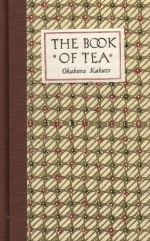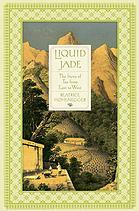TWO LEAVES AND A BUD: THE BOOKS OF TEA
REVIEWS BY LAUREN W. DEUTSCH
KYOTO JOURNAL 71
Spirituality: Okakura’s Opus
The Book of Tea by Okakura Kakuzo (1905, Various current sources, including (free) http://www.gutenberg.org/etext/769)

The Book of Tea, by Okakura Kakuzô (Tenshin) (1862–1913), is perhaps the best known single volume purportedly about tea written and published in English. I never knew anyone who drank tea, except iced tea in the summer. Decades before I cared about anything remotely Asian, I noticed the popularity of mini-versions of this book in suburban gift shops (think Hummel porcelain collectable figurines, crystal bud vases, greeting cards, etc.). Sibling topics such as “Ode on a Grecian Urn” and “Love Poems for Mother” always could be found as last minute impulse items near the cash register. One could surmise that if the gift recipient’s knick-knack shelves were full, one of these tiny, tastefully appropriate literary gifts could get one off the hook.
By all accounts Okakura, was a highly-educated expert on the arts and cultures of Japan, as well as those of China and India. “The origins of Okakura’s Book of Tea” are disputed. Some scholars believe it was conceived at Okakura’s summer home in Japan in 1905. Others believe it grew out of a set of discarded notes from a lecture series delivered to a group of women at Fenway Court.”1 Yet another noted the lecture was ostensibly to clarify Japan’s position in the Russo-Japanese War2. It was published posthumously in 1913 and translated into Japanese in 1929. According to the Izura Bijitsukan, the Tenshin Museum in Ibaraki Prefecture, Japan, the title of the Japanese translation of the book is Cha no Hon, literally tea’s book.
These were exciting, chaotic, confusing and yet “romantic” times, where cultural “purity” often took a back seat to both colonial and indigenous impulses to conjure up “traditions” and to take advantage of misinterpretations to support specific personal or political agendas. Commodification of the ethereal and consumption of artifacts for the purpose of boosting one’s social status was equally rampant on both “sides” of the “pond”: hunger for things exotically Eastern in the West countered the rush to Western-style modernity in the East.
Okakura was well suited for the role of arbiter, or as that Texas tongue-twister, the not-soon-enough-to-be ex-president of the USA G.W. Bush would say, “the explainer”. He played a key role in fashioning the prism through which the “orientalization of Asia was constructed.”3 His presence in Boston, Massachusetts was as a consequence of the flood of cultural material, especially “fine” arts, that was leaking by from Japan and China into the USA by shiploads.
At the same time he conceived of an art movement that combined Eastern and Western sensibilities, he employed tea to establish and solidify his critical relationship with the “Queen of Boston”, Mrs. Jack (Isabella Stuart Gardner), the “millionaire Bohemienne”4 and doyenne of the abovementioned Fenway Court. Regardless of his specific literary capacities, his aim was more universal than crafting an owner’s manual to accompany the set of utensils for “stirred tea” that he gifted Mrs. Gardner. “Humanity has so far met in the tea-cup” he said, “… we await the great Avatar. Meanwhile, let us have a sip of tea.” The book / lecture does cover much of the essential spirit of the legacy of chado deeply set within Japanese culture.
It has been said that the man was completely capable of living with one mind fully in two worlds, that he could look at the East from the West and vice versa. And this is one of the criticisms of The Book of Tea: that it was written from that Western hemisphere of his brain. Despite the literal presentation of all those “teas”: spirituality, authenticity, universality, Japanese propriety, etc., he was really positing that “The East and West, like two dragons tossed in a sea of ferment, in vain strive to regain the jewel of life.” 5
His metaphor was so seamless that even my fellow but Japan-born chajins have a hard time discussing it. They likewise have extreme difficulty understanding why anyone not Japanese would invest over two decades to learn the art form. When I ask them why they were so dedicated, it is merely because they are Japanese.
Sustainability: Hohenegger’s Liquid Jade(2006. St. Martin’s Press. New York.)
 The second “leaf” of the pick is not merely the finger pointing at the plant, but the plant itself — yes, camellia sinensis in glorious profusion — bursting anecdotes about ancestors, encompassing provenance to politics and philosophies and, most importantly, asks pointed question about the sustainability of the product and those whose livelihoods are dependent upon it.
The second “leaf” of the pick is not merely the finger pointing at the plant, but the plant itself — yes, camellia sinensis in glorious profusion — bursting anecdotes about ancestors, encompassing provenance to politics and philosophies and, most importantly, asks pointed question about the sustainability of the product and those whose livelihoods are dependent upon it.
In Liquid Jade: The Story of Tea from East to West (2006, St. Martin’s Press, New York), author / historian Beatrice Hohenegger has packed an enormous amount of information into a trim, enjoyable read. She charts the complexities of intrigue, trade and substance of that precious, enigmatic “elixir and commodity” from the depths of East Asia through the West of present day. “The more I researched historical events, the more the story of tea became the story of traumatic encounter and clash of cultures between East and West,” she states.
One enjoys rambling through the compact account, jumping from the mythic accounts of the discovery of the East’s renown proprietary medicinal plant and seemingly magical properties, its adoption into and impact upon well-established cultural patterns and agencies. From there, tea joins other “exotic” prizes of the East, such as opium, porcelain, silk and spices in the manifests of Western traders. Her book offers “curiosities, obscurities, misnomers and facts”, from botany to various twists and turns of the leaf as it makes it way from bush to bag and beyond. From China everywhere else, Hohenegger furnishes historical anecdotes from numerous sources as well as period black / white engravings related to tea. It is the perfect counterpoint to a gathering of friends and the solitude of private meditation. Whether East or West or in between, this simple, singular plant has kept true to its promises most patiently.
Unlike other recent tea-themed books that are content to report a contemporary surge in popularity of the beverage and pin varietals to the world map, Hohenegger puts forth for readers’ consideration how contemporary multinational corporations have taken over where colonial powers left off, contributing to the impoverished conditions of both the tea-growing soil and its caretaking indigenous population. She poses possibilities of organic farming, fair-trade practices, including a detailed account of how a Canadian woman has taken on tribal politics in the fertile Upper Assam region of India — replete with racketeering, extortion and murders — to help a small, indigenous tea-growing clan, the Singpho, to not only learn to grow their tea in sustainable ways for the earth, but also to control the entire vertical aspect of production, from field to processing for export. “The balance to be achieved among the various social, economic and cultural components is fragile.” Through the author’s farsightedness, tea joins coffee, chocolate and other ancient foodstuffs on the list of the earth’s most precious bounty.
----------------
----------------
1 Breslow, Rebecca G. “Humanity in a Tea-cup: Isabella Stewart Gardner and Okakura Kakuzo”, Chanoyu Quarterly No. 85, Urasenke Foundation, Kyoto, 1996.
2 Inaga, Shigemi “Reconsidering Okakura Tenshin as the Inventor of Oriental Art History” Abstracts of the 1999 Association of Asian Studies Annual Meeting, Boston 1999 http://www.aasianst.org/absts/1999abst/japan/j-toc.htm
3 Nothelfer, Frank G., “Rethinking Okakura Tenshin” Abstracts of the 1999 Association of Asian Studies Annual Meeting ibid.
4 Breslow, ibid
5 Okakura, Kakuzo (Tehshin), The Book of Tea
2 Inaga, Shigemi “Reconsidering Okakura Tenshin as the Inventor of Oriental Art History” Abstracts of the 1999 Association of Asian Studies Annual Meeting, Boston 1999 http://www.aasianst.org/absts/1999abst/japan/j-toc.htm
3 Nothelfer, Frank G., “Rethinking Okakura Tenshin” Abstracts of the 1999 Association of Asian Studies Annual Meeting ibid.
4 Breslow, ibid
5 Okakura, Kakuzo (Tehshin), The Book of Tea
